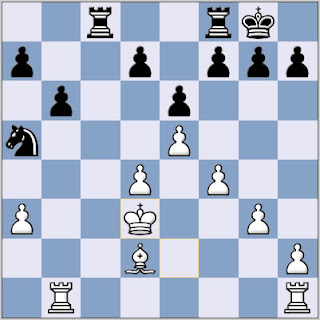
Roger Coathup - William Hulme, Hawick 2007.
Playing White, I'd given up a pawn in the opening, but received little in return. In this position (with Black to move) I was holding out some hopes of salvaging a draw after 1 ... Nc6; 2 Bb4 Nxb4; 3 ab.
Instead, Black played poorly:
1 ... Rc7?; 2 Bxa5 ba; 3 Rhc1!
And the threat of a back rank mate not only prevents Black from doubling rooks, but also forces him to concede the open file.
3 ... Rxc1; 4 Rxc1 Rb8; 5 Rc7
With an active rook and better king postion, White now has a clear advantage. Black's best try is probably 5 ... h5, stopping the mating threat and also looking to generate counterplay on the kingside by the manouevre Rb8-b2 x h2.
5 ... Kf8; 6 Kc2
Not the immediate 6 Rxa7 because of 6 ... Rb3+, followed by 7 ... Rxa3. I also avoided 6 Kc3, because of 6 ... a4! renewing the threat of ... Rb3 with gain of tempo. Kc2 also has the advantage of denying Black access squares on the b-file to activate his rook.
6 ... Ke7?!
Better is 6 ... a6 denying the White king access to the b5 square.
7 Rxa7 Rb5;
Attempts to go active now with ... Rb1, intending ... Rh1xh2, fail as White's a-pawn will advance too quickly.
8 Kc3 f6; 9 a4 Rd5; 10 Kc4 fe; 11 fe

The perfect illustration of the power of an active rook over a passive one. The rook on d5 has no moves, and Black has no good way to prevent Ra7-b7-b5 exchanging into a winning king and pawn ending.
11 ... Kd8; 12 Rb7! d6; 13 ed Rxd6; 14 Rxg7 h5; 15 Rg5 1-0
Recommended endgame reading (Amazon links):
Fundamental Chess Endings: A New One-volume Endgame Encyclopaedia for the 21st Century
Chess Endings: Essential Knowledge (Cadogan Chess & Bridge Books)

No comments:
Post a Comment